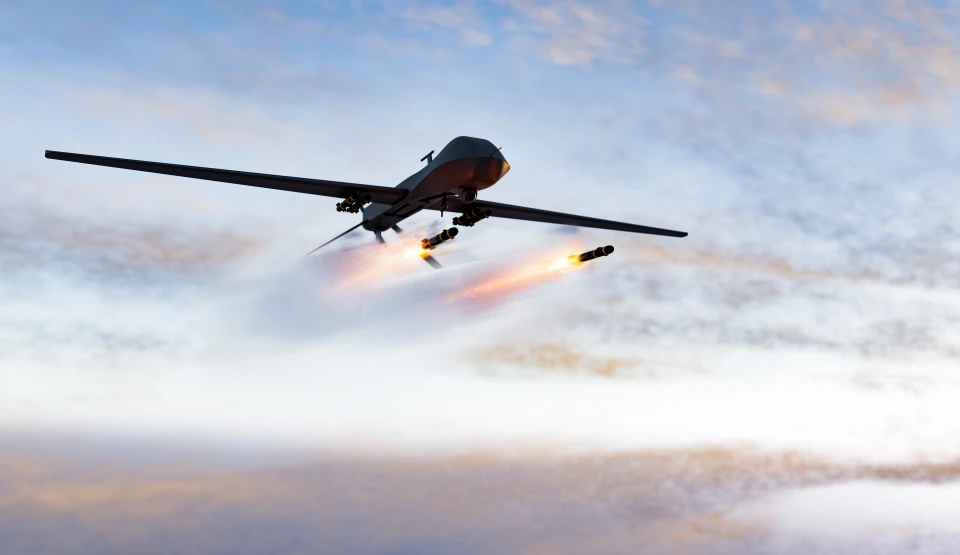
Ukrainian drone strikes St. Petersburg: Unveiling 1,000 km-range weapon
A nameless but formidable drone has made its mark with a bold attack. On January 18, under the cover of darkness, this Ukrainian drone targeted the St. Petersburg oil terminal, igniting a significant fire. What's intriguing is that it covered over a thousand kilometers from the Ukrainian border to reach its target
Espreso explains the specifics of this Ukrainian drone, exploring its impressive 1000 km range, technical features, and the motivations behind labeling it a tool of revenge.
Key points:
- The 1000 km flight range of the Ukrainian drone and its strike in St. Petersburg
- Technical details outlining the capabilities of the 1000 km range drone
- Information regarding the drone's background and unique features
- "Az Vozdam": the Ukrainian drone designed for revenge
The 1000 km flight range of the Ukrainian drone and its strike in St. Petersburg
On January 18, the Russian Ministry of Defense reported a drone attack on the Moscow and Leningrad regions. Official sources claim that air defense forces intercepted one drone over the Leningrad region.
Contrary to this, media outlets stated that a drone crashed onto an oil terminal in St. Petersburg. BAZA reported the launch of three drones, with two suppressed by anti-aircraft defense forces falling into the Gulf of Finland, and one shot down over the oil terminal. SHOT identified the drone as a 6-meter wingspan aircraft with a piston engine.

Photo: t.me/drozdenko
Ukrainian Pravda, citing a source in the special services, labeled the incident as a Ukrainian intelligence (GUR) operation.
The report quotes an interlocutor-specialist stating, "Military objects in St. Petersburg and the Leningrad region are now within the reach of Ukrainian forces." When asked if this was the first time Ukrainian drones attacked the Leningrad region of the Russian Federation, he answered: "Not the first time, but there are differences, and the enemy saw that."
The "Ukrainian footprint" was officially confirmed by Ukraine's Minister of Strategic Industries, Oleksandr Kamyshin, in Davos. He affirmed that the drone reaching St. Petersburg on January 18 was Ukrainian-made.
"We can produce drones at $350 apiece that can hit targets. This one, made in Ukraine, flew precisely 1,250 kilometers that night," said Kamyshin.
Notably, the St. Petersburg oil terminal, operational since 1996 near the oil filling area of the port of Leningrad, is the largest Russian oil product transshipment terminal in the Baltic region, with a throughput capacity of 12.5 million tons/year.
Technical details outlining the capabilities of the 1000 km range drone
In the fall of 2022, Ukroboronprom officially disclosed progress on a long-range drone, marking a significant development in Ukrainian military capabilities. Manufacturers confirmed reaching the final stages of its construction, heralding it as the longest-range addition to the Armed Forces' firepower. Key specifications included a 1,000-kilometer flight range and a 75 kg warhead. A published photo showcased a drone fuselage component.

"Ukroboronprom has been in heightened operation since the full-scale invasion. We may not share much publicly, but rest assured, what we're working on is proving successful on the battlefield, undergoing repeated successful tests," stated the announcement.
Defense Express analysts, basing their conclusions on available data, suggested the drone resembled a sizable kamikaze variant.
"Estimated parameters like wingspan and weight likely exceed 4 meters and 200 kg respectively. The intriguing groove observed could serve as a catapult hook, a launch rocket accelerator point, or possess an entirely different function," the report noted.
Regarding guidance systems, military experts favored conventional satellite navigation for hitting pre-known stationary targets. However, doubts arose concerning the drone's precision for striking specific military points.
"The compensation for accuracy concerns is massive production. This is especially evident when targeting enemy airfields," highlighted Defense Express.
Drawing parallels with Shahed-136 drones, experts emphasized the strategy of overwhelming air defense with a significant number of simultaneously launched drones. For Ukrainian long-range drones, mass production was deemed crucial to achieving the desired impact and overpowering enemy defenses. The use of high-tech autonomous guidance was deemed impractical due to the interception risk of individual drones.
"Installing a conventional thermal homing head with contour recognition in a land-based stealth cruise missile is far more effective, offering higher chances of penetrating enemy air defense than a slow-moving drone," clarified the experts.
Information regarding the drone's background and unique features
Fresh details about the "1,000 km drone" surfaced soon after the initial announcement from Oleh Boldyrev, the project manager at Ukroboronprom, who goes by the alias "Martin Brest."
Boldyrev clarified that the stated warhead of 75 kg is actually a measure of the payload. He explained that a warhead is an explosive device causing damage (75 kg is the warhead, larger than that of Shahed). In contrast, "payload" encompasses a broader scope, including cameras, communication systems, etc., in addition to the warhead.
"It's a versatile platform. We can make it a kamikaze. It can be adapted with various devices, electronic items, or simply function as a kamikaze following GPS coordinates," noted Boldyrev.
This design approach surprised Defense Express reviewers as different drone types usually follow distinct development strategies. Barrage munitions, for instance, are crafted from inexpensive components and aren't intended for landing; they make a single flight post-target impact. In contrast, a reconnaissance or reconnaissance-strike drone is built for a prolonged "life cycle" involving numerous takeoffs and landings, accumulating thousands of hours in the air.
The article stated, "No one globally creates a hypothetical Bayraktar TB2, with a 150-kg warhead, as an 'aircraft projectile.' These are fundamentally different concepts and development objectives for either 'military equipment' or 'munition.'"
Nonetheless, the developers sought an intermediate option. Boldyrev likened the development to the Iranian Shahed kamikaze drone but emphasized its reusability.
"The drone is already there. I'd call it 'patient zero.' It flies, serving as an attack or kamikaze drone. However, we, Ukrainians, are ambitious. We'll have a 'kamikaze' with the ability to return," Boldyrev stated.
This concept faced immediate criticism from Yuriy Kasyanov, the founder of the innovative research and production company A.Drones. He dismissed the "return" function as impractical and stressed the need for mass-produced, affordable kamikaze drones.
"The idea of a returning kamikaze drone – what's the point? Can we also make returning missiles and shells? We don't need PR projects from officials, nor singular examples of kamikaze drones at exorbitant prices, but dozens and hundreds of affordable kamikaze drones for mass attacks every day," Kasyanov commented.
"Az Vozdam": the narrative of this Ukrainian drone designed for revenge

Ukroboronprom revealed the testing of a confidential drone in the fall of 2022, progressing to flight tests amid electronic warfare influence.
"As directed by the Chief of the General Staff, we're preparing for flight tests under radio-electronic warfare. Weather poses a challenge, but it's an added check for the system, like a crash test. And yes, it involves more than one unit," mentioned the statement.
In a photo attached, the drone bears biblical inscriptions: "Az Vozdam." According to Ukroboronprom representatives, it's not a name but a "mission."
"Az Vozdam" is a Church Slavonic excerpt from the Gospel, specifically the Epistle to the Romans, referencing God's vengeance:
"Give place to the wrath of God, for it is written: Vengeance belongs to me, I will repay, says the Lord."
In January 2023, Nataliya Sad, a spokesperson for Ukroboronprom, stated, "The Ukrainian strike drone development, with a 1,000 km range, has progressed to a stage where details cannot be disclosed."

"We expedited the first sample's production, conducted air tests, and are gearing up for the next stage — showcasing the complex's capabilities to our country's Security and Defense Forces leadership," she added.
In November 2023, another drone mock-up surfaced online, featuring the words "Az Vozdam" and “Lyutyi” ("Fierce”), though neither serves as the drone's actual name. The drone also displays Ukraine's emblem stylized as a bird. Experts note similarities between the drone's appearance and the Bayraktar TB2.
- News












































